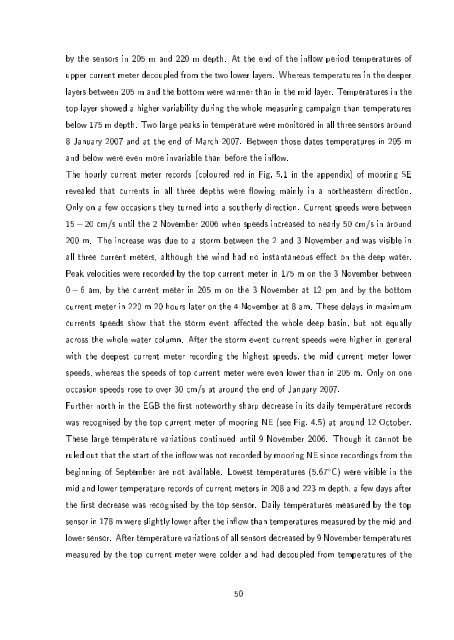Baltic Sea
Baltic Sea
Baltic Sea
You also want an ePaper? Increase the reach of your titles
YUMPU automatically turns print PDFs into web optimized ePapers that Google loves.
y the sensors in 205 m and 220 m depth. At the end of the inow period temperatures of<br />
upper current meter decoupled from the two lower layers. Whereas temperatures in the deeper<br />
layers between 205 m and the bottom were warmer than in the mid layer. Temperatures in the<br />
top layer showed a higher variability during the whole measuring campaign than temperatures<br />
below 175 m depth. Two large peaks in temperature were monitored in all three sensors around<br />
8 January 2007 and at the end of March 2007. Between those dates temperatures in 205 m<br />
and below were even more invariable than before the inow.<br />
The hourly current meter records (coloured red in Fig. 5.1 in the appendix) of mooring SE<br />
revealed that currents in all three depths were owing mainly in a northeastern direction.<br />
Only on a few occasions they turned into a southerly direction. Current speeds were between<br />
15 − 20 cm/s until the 2 November 2006 when speeds increased to nearly 50 cm/s in around<br />
200 m. The increase was due to a storm between the 2 and 3 November and was visible in<br />
all three current meters, although the wind had no instantaneous eect on the deep water.<br />
Peak velocities were recorded by the top current meter in 175 m on the 3 November between<br />
0 − 6 am, by the current meter in 205 m on the 3 November at 12 pm and by the bottom<br />
current meter in 220 m 20 hours later on the 4 November at 8 am. These delays in maximum<br />
currents speeds show that the storm event aected the whole deep basin, but not equally<br />
across the whole water column. After the storm event current speeds were higher in general<br />
with the deepest current meter recording the highest speeds, the mid current meter lower<br />
speeds, whereas the speeds of top current meter were even lower than in 205 m. Only on one<br />
occasion speeds rose to over 30 cm/s at around the end of January 2007.<br />
Further north in the EGB the rst noteworthy sharp decrease in its daily temperature records<br />
was recognised by the top current meter of mooring NE (see Fig. 4.5) at around 12 October.<br />
These large temperature variations continued until 9 November 2006. Though it cannot be<br />
ruled out that the start of the inow was not recorded by mooring NE since recordings from the<br />
beginning of September are not available. Lowest temperatures (5.67 ◦ C) were visible in the<br />
mid and lower temperature records of current meters in 208 and 223 m depth, a few days after<br />
the rst decrease was recognised by the top sensor. Daily temperatures measured by the top<br />
sensor in 178 m were slightly lower after the inow than temperatures measured by the mid and<br />
lower sensor. After temperature variations of all sensors decreased by 9 November temperatures<br />
measured by the top current meter were colder and had decoupled from temperatures of the<br />
50



